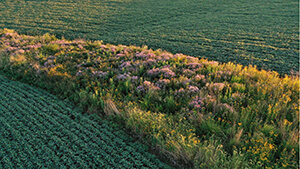
Agriculture is so dominant in some parts of the Midwest that you often see little else. For example, approximately 85% of Iowa’s land is currently used for agriculture, mostly corn and soybeans. If you’ve ever lived in Iowa or driven through the state, I’m sure you can picture the nearly endless fields of shimmering knee- and head-high greenery.
Corn- and soybean-dominated landscapes are not amazing for bees. Soybeans provide some pollen and nectar when they bloom, but corn provides no nectar and its pollen is far from preferred. With only a portion of Iowa’s remaining 15% of land containing flowers, there isn’t exactly an overabundance of food for pollinators.
But non-agricultural land in Iowa and other parts of the Midwest has the potential to expand. The U.S. Conservation Reserve Program (CRP) supports farmers through cost-share and rent payments to convert erodible or unproductive farmland into natural habitat under the goal of improving environmental health. When fields are reconstructed into native vegetation via the CRP, increases in abundance, diversity and health of pollinators, including honey bees, often occurs.
Of course, there can be resistance to taking entire fields out of agricultural production. Farmers have to make a living and we all have to eat, after all. One interesting new development on this topic is the STRIPS (Science-Based Trials of Row Crops Integrated with Prairie Strips) project at Iowa State University (www.prairiestrips.org). The focus of STRIPS is on embedding native vegetation within existing agricultural fields, not removing entire fields from production. Native prairie vegetation is established at field margins or natural contours within fields, which can have added benefits of reducing erosion and improving soil and water quality (Photo 1a,b).
Adding wildflower strips to fields sounds potentially good for bees, but is it? Do wildflower strips provide enough floral resources to notice real improvements in colony health and survival at nearby apiaries? These are the topics for the sixty-fifth Notes from the Lab, where I summarize “Native vegetation embedded in landscapes dominated by corn and soybean improves honey bee health and productivity,” written by Ge Zhang and colleagues and published in the Journal of Applied Ecology [2023].
For their study, Zhang and colleagues first established two to six prairie strips (ranging from 0.77-4.47 hectares, or 1.9-11 acres) at field edges and/or within corn or soybean fields at five farms. The authors waited three years for the strips to mature, then identified five control sites where prairie strips were not established. The five control sites were located in similar landscapes (similar percentage of agriculture, urban, and natural area) compared to the sites with prairie strips. All sites were located at least 3.2 km (2 miles) apart from each other, which is about 2-3 times the average foraging distance for honey bees. In other words, each site provided a unique replicate to assess whether prairie strips provided benefits to bees.
Between 2017 and 2019, a four-hive apiary was established at each site using package bees from the same genetic source. Colony growth (weight and bee population) was measured by inspecting and weighing each colony one to three times per month from May to October each year. Varroa mite levels and queen events were monitored monthly throughout the summer and bee-collected pollen was obtained, weighed, and identified once per month using a pollen trap and microscopy. Finally, overwinter survival was assessed from 2018-2019 and 2019-2020 by bringing all colonies to a common winter apiary in October, feeding supplemental sugar to all colonies to avoid potential starvation, applying miticides to all colonies, then checking mortality twice per month through March.
So, what did they find? Did bees at sites with prairie strips collect more pollen? Yes. Bees at prairie strip sites collected 50% more pollen compared to bees at control sites. Perhaps unsurprisingly, the pollen came from a wider variety of sources at the prairie strip sites (13 plants per sample period, on average) compared to control sites (2 plants per sample period, on average). In plant surveys, the authors found a total of 13 flowering plant taxa at control sites compared with 36 taxa at prairie strip sites.
Did greater pollen collection at prairie strip sites translate to improved colony health? Yes. As seen in Figure 1a, colony weight was greater at prairie strip sites starting in late July and continuing through early October. In general, there was also a larger adult bee population in colonies at the prairie strip sites compared to control sites, though this was only statistically significant in July and early October (see Figure 1b). The immature bee population was similar in colonies at the prairie strip sites compared to control sites (Figure 1c).
What about overwintering success? Was there improved overwintering for the colonies placed at sites with prairie strips? Yes and no. As seen in Figure 2, there wasn’t a statistically significant improvement in colony survival and spring adult bee population size in 2019 (see panels a and c), but there was better survival and a marginally significant increase in the spring adult bee population in 2020 (see panels b and d).
Well this is great news for honey bees. Are there also benefits for native pollinators at prairie strip sites? The authors didn’t directly assess whether native wild pollinators benefitted from prairie strips, but they did find that honey bees collected pollen from only 50% of the wildflower taxa at prairie strip sites. This means all the pollen and nectar from the other plants was available for native pollinators. In addition, some of the pollen and nectar from plants used by honey bees was likely available for native pollinators. In other words, native wild pollinators likely benefit from prairie strips even when honey bees are present, but again, this question wasn’t directly assessed in the authors’ study.
There’s current federal support for farms interested in installing prairie strips under CP43 of the Conservation Reserve Program. This is an exciting opportunity since it’s ….


